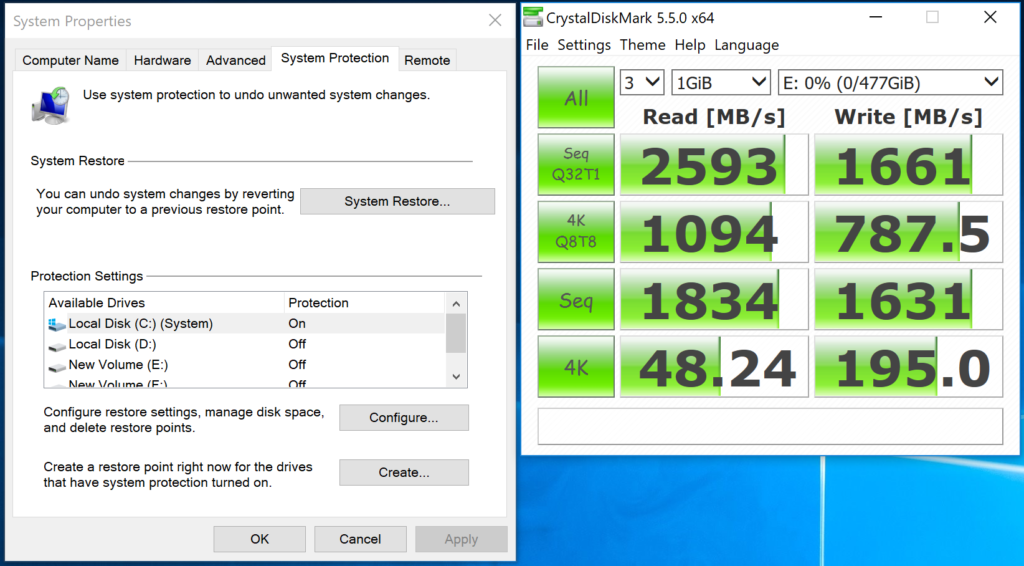OS OPTIMIZATION – DISABLE SYSTEM PROTECTION
Disabling system protection has been a recommendation of both the SSD community and manufacturers for some time.
As much as it saves valuable SSD space, it also eliminates shows a very slight improvement which is even more so if you happen to be running a test and a system backup is initiated in the background.
You can shut your System Protection off by following Start Orb/Control Panel/System/System protection/Configure…or just searching for “System Restore”.
INCREASE STORAGE SPACE – DISABLE PAGE FILE
Some of the most active discussions occur over the suggestion to disable the system Pagefile. Pagefile is a space saving optimization and can be reached by Start Orb/Control Panel/System/Advanced System Settings/Advanced/Performance/Advanced/Change and select ‘No paging file’. Don’t do it yet! Let’s discuss why we might shut this off first.
Way back in the days of Windows Vista and XP, memory was particularly expensive and the typical PC might have two to four gigabytes of memory installed. Today you will typically see eight to sixteen. So, Microsoft, in all their wisdom created Pagefile which was where a portion of the hard drive was used to ‘mimic’ memory and execute files quicker than might be expected. So let’s say you are using a software program. It might not be completely beneficial for that program to completely reside in your true memory, so it might be stored in Pagefile for quick access as well.
In present day, higher capacity memory has become commonplace, paired with the fact that Windows has done an amazing job improving its handling of memory during our typical PC activities. When is the last time you have seen a low memory warning in Windows 10? Now add to this the incredible speed of an SSD, compared to that ancient hard drive, and it makes no sense whatsoever to use our true storage instead of our memory. And this is what occurs. If you do not shut Pagefile down completely, it still uses your storage as memory. Which is faster, true memory or an SSD (or hard drive); true memory of course. The fail-safe here of course is, if it doesn’t suit your needs, you can always enable it again. The true benefit is a whole lot of storage capacity being returned to your power when shut off.
INCREASE STORAGE SPACE – DISABLE HIBERNATION
If you care to search the internet, you can find countless instances of PC’s failing to restart after hibernation, or simply crashing. This was a problem more so a while back but there are still plenty of examples of it today. Your system goes to sleep and doesn’t wake. Turning hibernation off prevents this, but just as important, it saves you valuable storage space and you can turn it back on if you choose.
To turn hibernation on or off, one needs to go to Start Orb/Windows System/right click on ‘Command prompt’ and choose ‘Run as Administrator. From there, simply type ‘ powercfg.exe /hibernate off (or ‘on’ as you choose). That’s the good thing about this guide; you can simply reverse the process to get back where you started if you don’t like the results.
INCREASE STORAGE SPACE – DISABLE RECYCLE BIN
Are you daring enough to believe you might never use Recycle Bin to find something you accidentally deleted? If so, the benefit here is once again increase storage being returned to the user. To turn off Recycle Bin, right click on the Recycle Bin and select “Don’t move Files to the recycle Bin’ and select OK.
 The SSD Review The Worlds Dedicated SSD Education and Review Resource |
The SSD Review The Worlds Dedicated SSD Education and Review Resource | 

